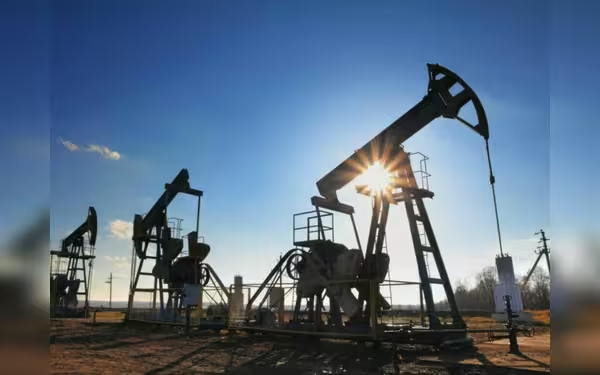Saturday, November 16, 2024 05:44 PM
Oil Prices Surge Amid U.S. Election Aftermath
- Oil prices fluctuate post U.S. presidential election.
- China's crude imports decline for six consecutive months.
- Hurricane Rafael impacts U.S. Gulf crude output significantly.
 Image Credits: brecorder
Image Credits: brecorderOil prices rise as investors react to U.S. election outcomes, with significant impacts from China imports and Hurricane Rafael.
Oil prices have recently experienced fluctuations, primarily influenced by the aftermath of the U.S. presidential election. Following Donald Trump’s election victory, the oil market saw a significant sell-off, with prices initially dropping more than $2 per barrel. This decline was largely attributed to a strengthening U.S. dollar and a decrease in crude imports from China, which outweighed concerns regarding supply disruptions linked to Trump's presidency and the impact of Hurricane Rafael.
As of Thursday, Brent crude oil futures were down by 63 cents, settling at $74.29 a barrel, while U.S. West Texas Intermediate (WTI) crude fell by 73 cents to $70.96. The market is currently facing several downside pressures, including a robust dollar and sluggish demand for oil. However, potential upside factors, such as increased sanctions on Iran and Venezuela under Trump’s administration, as well as ongoing conflicts in the Middle East, are also at play.
Analysts, including Ole Hansen from Saxo Bank, have noted that while some of these factors may not have an immediate impact, they contribute to a narrative that suggests rangebound trading in the oil market. Hansen expressed that, “Absent any major geopolitical escalation, the short-term outlook leans toward downside risk in my opinion.” This sentiment reflects the cautious approach investors are taking as they navigate the complexities of the current market.
The dollar's strength is a significant factor in the oil market, as it makes oil more expensive for holders of other currencies. This dynamic tends to exert downward pressure on oil prices. Priyanka Sachdeva, a senior market analyst at Phillip Nova, pointed out that while Trump’s policies have historically favored business growth, which could boost fuel demand, any interference with the Federal Reserve’s easing policies might pose challenges for the oil market.
Further complicating the situation, data revealed that China’s crude oil imports fell by 9% in October, marking the sixth consecutive month of year-on-year declines. Additionally, U.S. crude inventories have risen, adding to the downward pressure on prices. Trump is anticipated to reinstate his “maximum pressure policy” on Iranian oil exports, which could potentially reduce supply by up to 1 million barrels per day, according to estimates from Energy Aspects.
Moreover, actual supply cuts are also influencing the market. The U.S. Gulf of Mexico has seen about 17% of its crude output, or approximately 304,418 barrels per day, shut down due to Hurricane Rafael, as reported by the U.S. Bureau of Safety and Environmental Enforcement. This combination of factors creates a complex landscape for oil prices, leaving investors and analysts alike to ponder the future of the market.
The oil market is currently navigating a challenging environment shaped by political developments, economic indicators, and natural events. As investors keep a close eye on these dynamics, it is essential to remain informed about how these factors may influence oil prices in the near future. Understanding these trends can help individuals and businesses make more informed decisions in an ever-evolving market.













